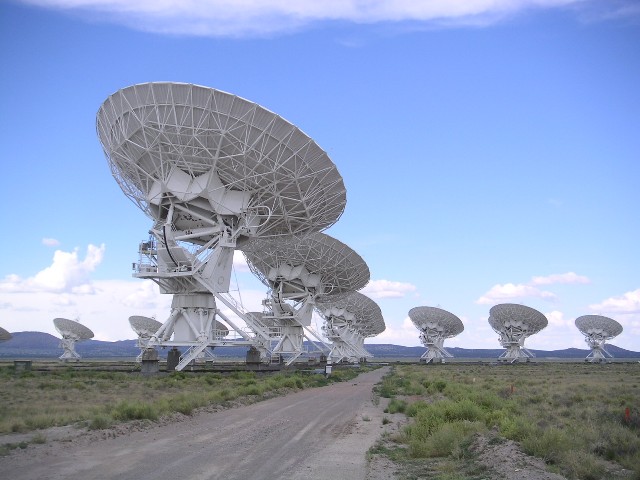EE4715 Array Processing
Introduction
In array signal processing, we look at the information contained in the outputs of multiple sensors: antennas or microphones. Thus, we sample in space as well as in time. This allows us to estimate the direction of propagating waves, and to separate multiple sources coming from different directions. Prime examples are capacity increase using MIMO technology in wireless communication, image formation from radar, ultrasound or radio astronomy (i.e., wavefield imaging), sound field reconstruction and multi-microphone hearing aids.
In this course we discuss array processing techniques for signal separation and parameter estimation, using arrays of sensors. We start with wave propagation and derive the signal processing model for narrowband applications, followed by the wideband extension, and apply these to several applications: wireless communication, audio and speech processing, biomedical signal processing and radio astronomy.
The course consists of plenary lectures and two projects.
For study guide information (teaching goals, etc.), see Study guide.
Plenary Lectures
The plenary lectures cover the main subjects of the reading material (see the Program below), but do not aim at being all-encompassing. By following the plenary lectures, easier access is gained to the reading material, and a clearer insight is obtained as to why certain subjects are relevant and how they relate to other subjects already covered. An older version of this course can be accessed via: Signal Processing for Communications, where you can find old slides and videos. Note though that the content is not the same.
Book
We will follow the course reader "Array signal processing" by A.J. van der Veen.The reader serves as introduction to handout papers from the literature.
Projects
During the course, two projects are conducted. These projects are part of the final examination. The project work is carried out in groups of 2 students. As the project reports will be discussed during the evaluation, participation in the projects is compulsory to qualify for the course.
Project descriptions are found by clicking on the panel at the top right of this page.
Exam
The course is evaluated based on two individual oral discussions that will be scheduled at two different moments. To qualify for the oral examinations, the project reports documenting the projects must be handed in in advance. You are allowed to bring books and slides to the oral exam. During the oral examinations, your project report is used to discuss contents from the course. The final grade is the average grade on the two discussions.
Deadlines
Prepare your final report for each of the two projects per group of 2 students. Upload your report individually before the deadline given below.
- Oral exams: sign up for a time slot when announced
- Project reports: submit both reports before June 18th, 2025
To sign up for the oral exams: in Brightspace, go to the tab "Collaboration", choose "Groups" and then select "Project 1" or "Project 2", and sign up for a time slot for each of the discussions.
To submit your project reports: in Brightspace, go to the tab "Assignments".
Teachers
The responsible teachers for this course are prof.dr.ir. G.J.T. Leus (GL), dr.ir. Richard C. Hendriks (RCH) and prof.dr.ir. A.J. van der Veen. (AJV)Program
The program for the study year 2024 - 2025 is as follows:
| Date | Content | Literature | Slides | ||
|---|---|---|---|---|---|
| 1. | 23/4/2025 | GL | Introduction. Wave propagation | Ch. 1, 2 | Introduction
Wave propagation |
| 2. | 25/4/2025 | GL | Narrowband data models | Ch. 3 | Narrowband |
| 3. | 30/4/2025 | GL | Wideband data models | Ch. 4 | Wideband |
| 4. | 2/5/2025 | GL | Linear algebra 1: Projections/inversion and Spatial processing techniques; Wiener filters | Ch. 5, Ch. 6 | Linear algebra, Spatial processing |
| 5. | 7/5/2025 | GL | Linear algebra 2: SVD, EVD. The ESPRIT algorithm | Ch. 8 | ESPRIT |
| 6. | 9/5/2025 | AJV | Kronecker products. Joint diagonalization | Ch. 9 | Joint |
| 7. | 14/5/2025 | AJV | Factor Analysis |
Ch. 10 | Factor |
| 8. | 16/5/2025 | RCH | Multi-microphone speech enhancement 1 | overview paper multi-microphone | multi-mic. 1 |
| 9. | 21/5/2025 | RCH | Multi-microphone speech enhancement 2 | multi-mic. 2 | |
| 10. | 23/5/2025 | RCH | Multi-microphone speech enhancement 3 | multi-mic. 3 | |
| 11. | 28/5/2025 | RCH/JdV | Multi-microphone: Signal Processing-based models of binaural hearing in combination with beamforming. | Binaural beamforming | |
| 12. | 4/6/2025 | Guest lecture on ultrasound, P. Kruizinga (Erasmus MC) | |||
| 13. | 6/6/2025 | reserve |
|
||
| 14. | 11/6/2025 | GL | Q&A parts 1 Overview of graduation topics on part 1 |
||
| 15. | 13/6/2025 | RCH &GB | Multi-microphone: ATF estimation and CRLB Overview of graduation topics on part 2 |
||
| 18/6/2025 | Deadline projects 1 and 2 |
More slides on selected topics in array processing are found here.
